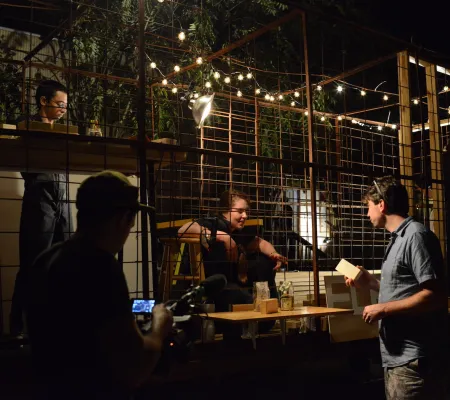We both are and are not entirely conscious of where it starts and where it ends.
Michael Colaianni is one of six members of the newly-formed artist collective, Fleet, featuring current and former UT Austin students, Colaianni, Haley Hill, Brooke Johnson, Emily Lee, Tín Rodriguez, and Connor Walden. Their collaborative work centers around reactions to changing physical and conceptual environments, as well as responses to the current political climate that are performed through a lens of absurdity. Most recently, they were chosen to complete the fourth installment of the temporary, site-specific installation series Cage Match Project by UT Studio Art Lecturer Ryan Hawk. Work in Progress opened on September 9, 2017.
The location of the performance piece, in the Cage Match Project’s industrial cage-trailer outside Canopy studios in East Austin, played a key role as the collective meant to critique cultural production within certain designated makerspaces and commodification of the art object. The performance piece features all six collaborators in the process of constructing and selling the wares of a pop-up shop out of the Cage Match Project’s industrial cage-trailer. Members of the collective divide into two roles: front-end and back-end of the operation. Those on the back-end set about building the outside display of the shop and on the front-end there are those upselling Fleet’s wares.
Through attendant detail to the hallmarks of the construction line, Fleet complicates a perceived divide between construction and craft. Brooke Johnson and Tín Rodriguez sell the shop’s sole product: the identical, if somewhat shorter, 2-by-4 pieces of wood being used to construct their shop’s display. The two recite marketing statements on a loop as their presumed customers advance to the trailer, such as: “Don’t miss out on this opportunity for a hand-crafted, artisanal work of art!” Johnson said that it was most important to her to emphasize the “unique,” “artisanal,” “craft aesthetic” and “handmade” quality of the objects she was selling, as a way of throwing sharp relief on the identical nature of materials sold as precious objects and those used functionally in the construction of the shop. Fleet means to call attention to the unseen labor of today’s marketable craft aesthetic, the kind of casual branding that makes craft brewing and artisanal soaps a phenomenon versus a passing hobby.
A highlight of opening night involved one young viewer/customer that had a revelation, “One of my favorite interactions was with this little kid that I was giving one of our blocks to,” said Johnson. “I was walking through my script, some of it improvised, and he immediately made the connection, exclaiming, ‘It’s the same block! It’s the same one!’ Which is exactly what we were getting at and he just immediately knew there wasn’t a difference.”
This isn’t the first time the six members have worked together. Their final performance in Transmedia Professor Michael Smith’s performance art course featured a Y2K party on the rooftop deck of the Art building. In a macabre countdown until a millennial apocalypse, the six performed escalating, absurdist rituals, including celebrating a “Happy Rebirthing” to a “sacrifice” involving a vegan eating cake. As close to a third of their Performance class, the Fleet members were given the support and encouragement they needed to pursue projects outside of class. “Both Professor Michael Smith and our TA, Ryan Hawk, gave us lots of encouragement, confirming the thing we already felt: that we worked well together,” said Emily Lee. “I also appreciated the critiques that we were given by our instructors and peers, not just that we received them, but that they were consistently intense, constructive and discussion-based.”
Tín Rodriguez is the only member of the collective that is not a Studio Art major. Instead, Rodriguez comes to Fleet as a Biology major who knew a few classmates through his work on the local zine, Deadly Toxin. But he found that the arts courses, including the Performance Art course that introduced him to his Fleet collaborators, were a necessary accompaniment to his course load, allowing him a challenging outlet for creative energies. Other members in the collective either came to Smith’s course from a background in Art History or with less experience in performance than other mediums. “Performance classes impacted the way I worked in my Studio classes and how I approached my academic work in general,” said Haley Hill. “I started thinking of the work I was doing as an artistic performance, influenced by my self-awareness of motivation and movement.”
As Fleet, the group has been granted a Professional Development Travel Initiative by the College of Fine Arts to travel to New York City in the first weekend of November to attend Performa 17, a performance festival dedicated to exploring the critical role of live performance in the history of twentieth-century art. Before then, they’ll finish out Work in Progress with a final performance. This might be the best time to answer the question: Why “Fleet?” For lack of better phrasing, performance is fleeting. The sculpture and objects left in the open-air cage after their initial performance have been subject to the elements and what’s left are part evidence, part remains. To return to the scene of the initial performance requires reframing. Discussing their final performance, Colaianni remarks, “We’re going to have to rebrand for the final performance with merchandising text like, “EVERYTHING MUST GO!” Final performance on Oct. 29, 2017.


